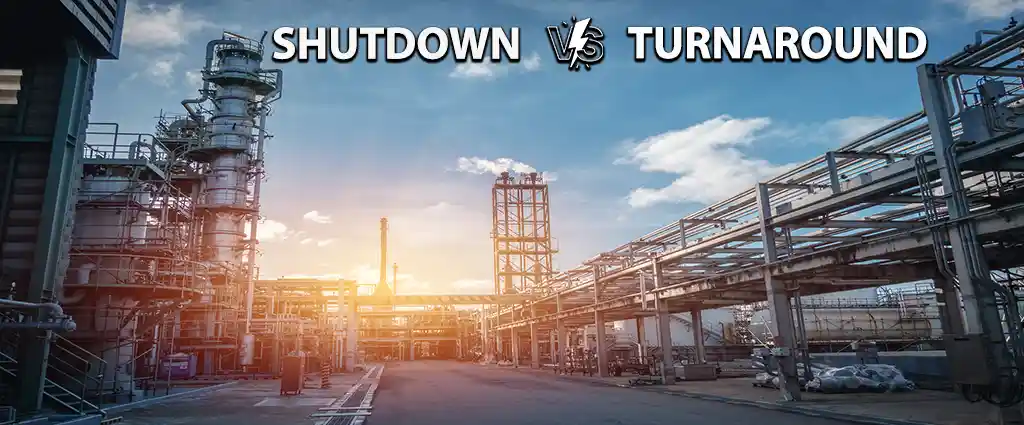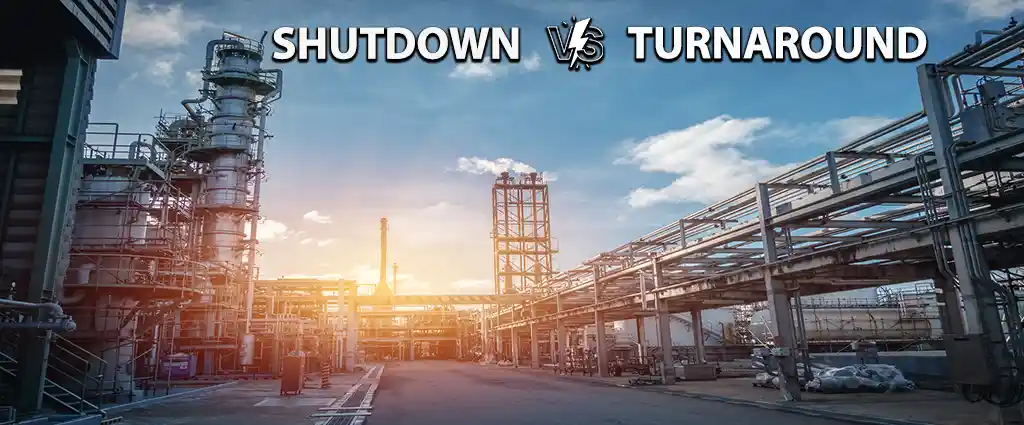Shutdown
A shutdown in the oil and gas industry is a temporary cessation of production or operations for a specific reason. Shutdowns can be planned or unplanned.
Planned shutdowns are typically scheduled for maintenance or inspection purposes. They may also be necessary to make changes to equipment or facilities. Unplanned shutdowns can be caused by a variety of factors, such as equipment failure, power outages, or natural disasters.
Turnaround
A turnaround in the oil and gas industry is a planned, periodic shutdown of a refinery or petrochemical plant for the purpose of maintenance, inspection, and repair. Turnarounds are typically scheduled every few years and can last for several weeks or even months.

During a turnaround, all equipment and facilities are inspected and repaired, or replaced if necessary. Turnarounds are also an opportunity to make changes to equipment or processes to improve efficiency or safety.
Differences between shutdowns and turnarounds
The main difference between a shutdown and a turnaround is that shutdowns can be planned or unplanned, while turnarounds are always planned. Turnarounds are also typically more complex and time-consuming than shutdowns.
Another difference is that shutdowns are typically carried out by the plant’s own maintenance staff, while turnarounds may involve contractors from outside the company.
Few more differences on the basis of
Objective:
Shutdown: Shutdown refers to the temporary cessation of normal operations at a facility for various reasons such as equipment maintenance, repair or inspection. It may be planned or unplanned and vary in duration.
Turnaround: Turnaround is a planned and scheduled program during which a plant or facility is taken offline for a specified period of time to perform comprehensive maintenance, repairs, and upgrades. Turnarounds are generally more comprehensive and strategic than regular shutdowns.
Duration:
Shutdown: Depending on the specific maintenance or repair operations, the duration of the shutdown may vary from a few hours to several days.
Turnaround: Turnarounds are typically more extended events, often lasting several weeks or months, to allow for extensive maintenance, inspection, and major upgrades.
Scope of work:
Shutdown: The scope of work during a shutdown is generally limited to specific tasks or repairs, and may not include all of the facility’s equipment and systems.
Turnaround: Turnaround involves a more extensive scope of work, including inspection, maintenance and overhaul of a wide range of equipment and systems, ensuring long-term reliability of the plant.
Plan:
Shutdown: Shutdown can be planned or unplanned depending on immediate maintenance needs. Unplanned shutdowns can disrupt operations and be costly.
Turnaround: Turnarounds are carefully planned in advance to minimize downtime and maximize the efficiency of maintenance activities. These are scheduled strategically during periods of low demand.
Frequency:
Shutdown: Shutdowns may occur more frequently and as needed to resolve specific equipment or system problems.
Turnaround: Turnarounds occur less frequently and at predetermined intervals, often based on equipment lifetime, industry standards, or regulatory requirements.
Cost:
Shutdown: Shutdown costs are generally lower than turnarounds, as they involve only specific, immediate maintenance or repair tasks.
Turnaround: Turnarounds are more expensive due to their broader scope and longer duration. However, they are essential to ensure the long-term operational efficiency and safety of the facility.
So we can say that shutdown is a temporary interruption of operations for specific maintenance or repair tasks, while a turnaround is a strategically planned event for comprehensive maintenance and upgrades that occur at less frequent intervals. The main differences lie in their objective, duration, scope of work, planning, frequency and cost.
Benefits of shutdowns and turnarounds
Shutdowns and turnarounds are essential for maintaining the safety and reliability of oil and gas facilities. They also help to ensure that the facilities are operating efficiently and that they meet all applicable environmental regulations.
Conclusion
Shutdowns and turnarounds are both important parts of the oil and gas industry. They help to ensure the safety, reliability, and efficiency of oil and gas facilities.
Read Also
Download Free Piping PDF for Interview Preparation
What is gasket and their types
What is a valve and its types?

1 thought on “Shutdown vs Turnaround: Key Differences for Oil and Gas Industry Professionals”